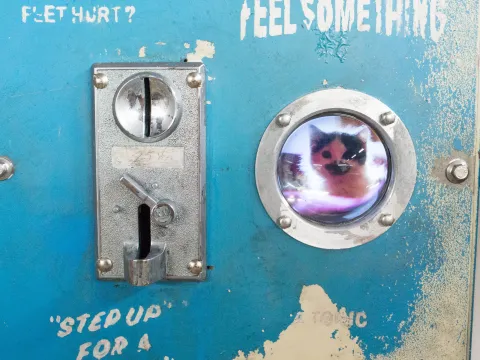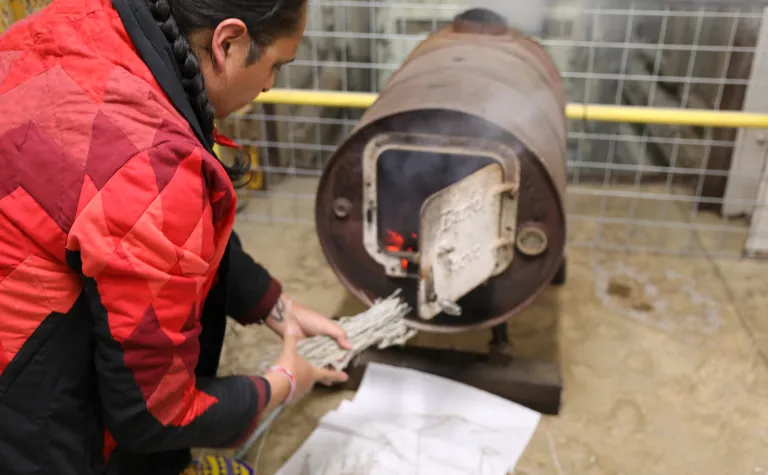Chris Combs Named 2025 Artist in Residence at Sanford Underground Research Facility
Combs, a Washington, D.C. based artist, is a sculptor who works with electronics. He will begin his residency in June at America’s Underground Lab.
Albert Einstein’s famous quote, “Imagination is more important than knowledge,” speaks to the immense value of creativity in the scientific process.
It takes imagination to leap into the unknown, and it takes great feats of knowledge to land on the truth. The value of the creative spark in setting the stage for eureka moments is one reason the Artist in Residence (AiR) program at the Sanford Underground Research Facility (SURF) has continued strong for the past six years.
Chris Combs, a Washington, D.C. based artist, has been named the 2025 AiR at SURF. Combs is known for his inventive coupling of technology and found materials that provoke thought about society’s evolving relationship with the digital world.
A tour of his studio at Otis Street Arts Project, might include interactive arcade machines that reveal pictures of cats, reimagined electrical boxes with LCD screens flashing images of vintage magazine ads, or an acrylic window to a box that reveals video of fish that live in an isolated water hole in the desert of southern Nevada. See a video studio tour here.

All of these creations are powered by electronics like a Raspberry Pi or a circuit board built from scratch, with computer programming completed by Combs. His art combines elements of engineering and storytelling enabled by his mastery of electronics and automation. The work draws attention to the rapid technological shifts shaping modern society.
“The art I make is concerned with how our world has changed so quickly around us. We adapt to a new technology and move on with our lives, almost forgetting that it used to be done differently. So, in my artwork, I like to take a specific aspect that has changed and try to make it physical,” Combs said.
During his residency at SURF, Combs plans to engage with the laboratory’s pioneering research in particle physics, including experiments on neutrinos, dark matter, and stellar nucleosynthesis.
“I’m so excited to be able to metabolize and share the incredible physics that’s being done at SURF in this underground environment that speaks to human ingenuity,” Combs said. “It seems like the work being done here could have such interesting ramifications for all of humanity and our origins in the universe.”
He hopes this visual storytelling will connect the public with the groundbreaking science happening deep underground.
“There’s a lot of potential for doing artsy science communication—showing the world, ‘Hey, we’re doing this wild stuff,’” Combs said. “It might have totally zany implications that could upend our understanding of the standard model of physics—or not. Anything could happen, and that’s what makes it so exciting.”
The idea that anything can happen in scientific discovery or artistic exploration is also exhibited in Combs' work.
“If I knew how a given artwork would end up, it would be kind of boring to make it,” he said. “Science is similar—researchers are looking for answers to things we don’t yet understand.”
Combs' residency runs from mid-June to mid-July. He will document his experiences at SURF and present a gallery exhibition to the public at Black Hills State University’s Ruddell Gallery in the fall of 2025. SURF’s ongoing partnership with Black Hills State University is also part of the strength of the AiR program.
“The SURF AiR program has been instrumental in giving a timeline to the work taking place at SURF,” said Gina Gibson, AiR program coordinator at SURF and a professor of digital communication at Black Hills State University. “Each year, a new artist reacts to their experience above and below ground. They connect with scientists, engineers, and educators. The artwork they create contributes to SURF’s permanent art collection.”
Gibson points out the value of the AiR program in achieving SURF’s mission to advance world-class science and inspire learning across generations.
“Chris brings an exciting new style to the SURF AiR program,” Gibson said. “His use of technology and asking big questions mirrors the type of work being done at SURF. I look forward to seeing and interacting with the artwork that is produced from his experience.”
There is no question that Combs' work and time at SURF, along with the previous five artists in residence at the facility, can yield the sparks of imagination that Albert Einstein found so valuable in empowering breakthrough ideas.
This residency is modeled after various programs offered by government, science, and industry, including the National Park Service, CERN, and Fermilab. For more information visit SURF AiR program website.



